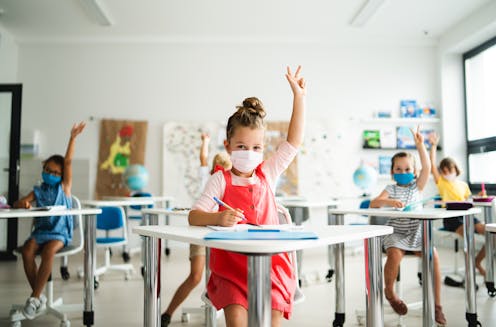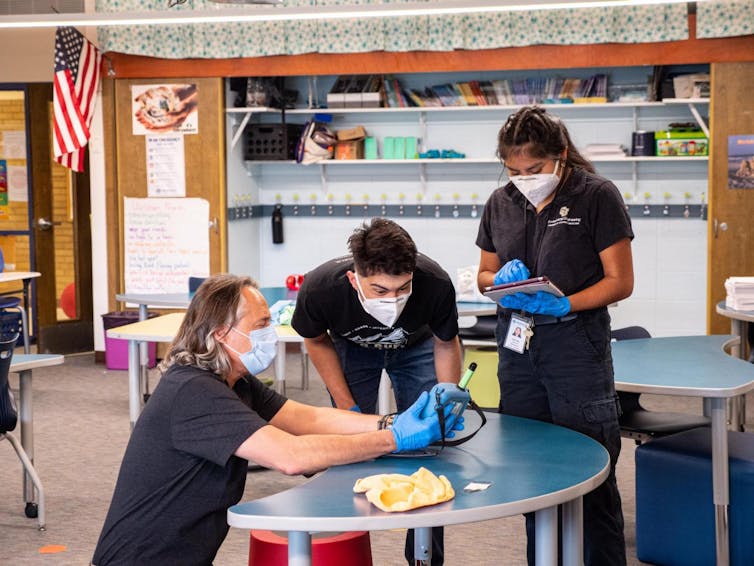COVID-19 has spurred investments in air filtration for K-12 schools – but these technologies aren't
Air-ventilation upgrades have been badly needed in U.S. classroooms since long before the pandemic. Low-tech filtration systems that cost about the same as a textbook per student can make a big difference.

The COVID-19 pandemic has brought increased attention to indoor air quality and the effect that ventilation has on reducing disease transmission in indoor spaces. A recent infrastructure survey reported that of the nearly 100,000 operating public school buildings across the U.S., more than a third have an immediate need for upgrades to the ventilation systems that help control indoor air quality and the spread of “aerosols.”
Aerosol is the term used to describe the millions of microscopic particles that float in air – both indoors and out. People constantly inhale and exhale aerosols, some of which include allergens, particles from automobile exhaust, wildfire ash and microbes.
Our University of Colorado environmental engineering team has been studying the microbiological components of indoor air, called “bioaerosols”, for more than 25 years. We have surveyed the ventilation systems of hundreds of K-12 classrooms, health care facilities and restaurants. And we have provided facilities managers with affordable plans to improve indoor air quality.
Our own work as well as others’ has found that many classrooms are unfortunately poorly ventilated, and that better ventilation can reduce student absences due to illness – both during a pandemic and more normal times.
After surveying the installation of air filtration systems over the past year, we found that they can significantly improve air quality in classrooms by lowering aerosol levels, which in turn lowers COVID-19 transmission risk. But effective installation is key.
A new age of filtration
As the pandemic continues to highlight the need for better ventilation and indoor air quality, many academic institutions, government agencies, nongovernmental organizations and professional building science societies have been promoting better building-management practices to improve school ventilation.
Some building scientists have called for bringing the ventilation conditions in schools up to the levels prescribed for medical clinics. Unfortunately, the infrastructure investments required for that level of upgrade are well out of practical reach for many public buildings: Between 2008 and 2017 alone, state capital funding for schools was cut by $20 billion, or 31%.
In the absence of funding for major building upgrades, simple in-room filtration technologies have been installed in some schools to improve ventilation in classrooms where many students spend their days in close quarters. However, these filters have only been deployed in a small fraction of public schools across the country.
This technology, called high efficiency particulate air (HEPA) filtration, was born in the aerospace industry more than 50 years ago. HEPA filtration has been proved to efficiently remove microscopic airborne particles – including respiratory viruses – from air in higher occupancy spaces like classrooms.
Over the past few years, a new generation of HEPA filters have emerged from the U.S. commercial sector. These filters are more compatible with educational settings and less intrusive than their research-grade counterparts that are commonly used in the aerospace and pharmaceutical sectors, where “clean rooms” are needed. These latest models include improvements like multidirectional intake, reduced noise, lower power requirements, better durability and relatively small footprints.
HEPA filters have also become more widely used over the past couple of decades in homes in response to the recognition of rising asthma rates among children. But until the COVID-19 pandemic, they were rarely used in public school settings.
Bringing fresher air to classrooms
Over the 2021 spring academic semester, our team installed hundreds of new HEPA filters in public elementary classrooms in Denver, Colorado, the largest metropolitan school district in the Mountain West. These upgrades were possible due to a recent industry-university cooperative effort between the University of Colorado, the Intel foundation and the Carrier Corporation, a multinational ventilation equipment company. Together, these organizations contributed more than $500,000 for large-scale ventilation assessments, HEPA filter installations and other air quality improvements for Denver-area schools.

A yet-unpublished poll of teachers in many of those classrooms overwhelmingly reported that this new generation of HEPA filters were welcome and easy to accommodate in their classrooms.
But like all engineering solutions, air filter effectiveness depends on proper installation. Our team’s field studies demonstrate that a simple “plug-and-play” approach will not address the complicated reality of aerosol exposures in densely occupied classrooms. In many situations, we have found HEPA filters that were undersized and placed inappropriately – such as facing a wall or in a remote corner – and sometimes not even turned on.
Networks of HEPA filters need to be thoughtfully installed, and the process must take into consideration other factors such as existing ventilation system performance, ceiling height, desk layouts and the presence or absence of ceiling fans. HEPA filters can only work up to their full potential if schools have the right number of them, they are the appropriate size and are placed in optimal positions.
The best HEPA filter installations consider details like student seating charts, high traffic areas and other variables based on student behaviors. Fortunately, building facility managers and custodial staff can be trained, with modest time investment, to install, operate and maintain HEPA filters in classrooms, with minimal distraction to teachers.
Air quality improvements are an investment in health and education
A 2020 review on indoor air quality strategies estimates that an individual HEPA filter, sized for elementary school classrooms with average energy use, costs about $361. This is consistent with our team’s experience in the Denver Public Schools system, where we typically installed at least two units per classroom at a cost of less than $800 per room. We estimate that this is roughly equal to the cost of one extra textbook per student over an academic year. In our opinion, that is well worth the potential improvement in indoor air quality in classrooms.
In-room HEPA filtration is a long-term investment that supplements existing ventilation systems. And though COVID-19 was the impetus for the installation of many HEPA filters, they are effective for far more than just reducing exposures to airborne viruses. Well-maintained and properly functioning filtration systems also reduce exposure to wildfire ash that can penetrate buildings, as well as allergens and other unwanted particles like automobile exhaust, tire detritus and construction dust.
But even the best indoor HEPA filtration cannot guarantee protection from airborne respiratory threats in schools. HEPA filters are effective only as part of an integrated approach. Ultimately, masks, distancing and reducing the number of students packed into tight spaces will determine how well students are protected from COVID-19.
HEPA filters are the modern analogy of “seat-belts” for indoor air quality in the age of COVID-19. If fitted correctly, they can only help lower the exposures to COVID-19 and other aerosols that students experience during their school days.
[Understand new developments in science, health and technology, each week. Subscribe to The Conversation’s science newsletter.]
Mark Hernandez receives funding from the National Science Foundation and National Institutes of Health, as well as a host of public and private companies and philanthropic organizations supporting air quality research in our built environment, including the Reckitt company, the Clorox company, the Intel Foundation, and the Ryan Innovation Group.
Read These Next
Data centers need electricity fast, but utilities need years to build power plants – who should pay?
How many data centers will be built – and how much electricity they’ll need – is uncertain. Being…
Whether Netflix or Paramount buys Warner Bros., entertainment oligopolies are back – bigger and mor
Hollywood has seen this movie before.
How a niche Catholic approach to infertility treatment became a new talking point for MAHA conservat
Mainstream medical organizations have criticized ‘restorative reproductive medicine,’ but some Catholics…






